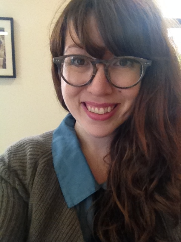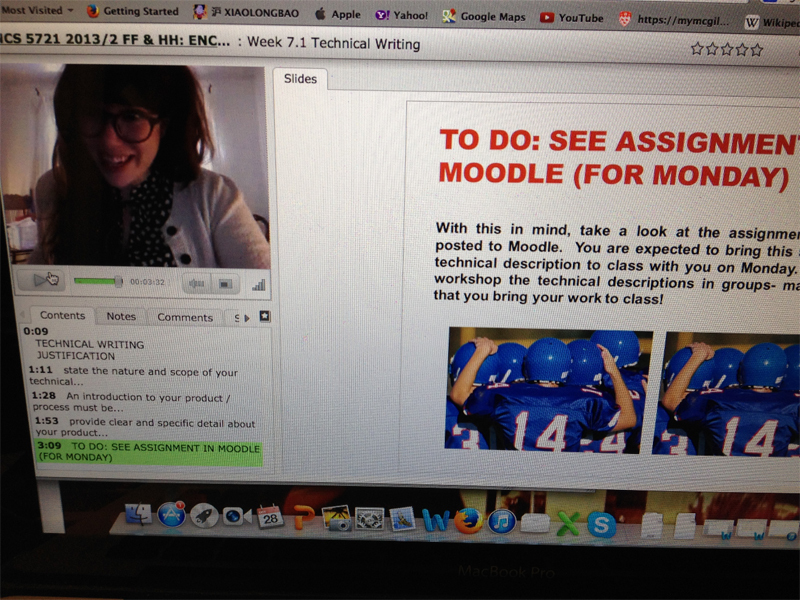Generating Content for the Flipped Classroom Using Panopto Software

Casey Burkholder, Instructor Concordia University
In an interview with Casey Burkholder, she mentioned that Deborah Dysart-Gale, Chair and Associate Professor of the Center for Engineering in Society, promoted a hybrid course design for graduate level engineering students in a writing course on technical writing for computer scientists and engineers. Burkholder taught one section of this technical writing course where students completed most of their work outside of class and brought their results to class for revision. In effect, she ran the course like a writing workshop, creating lecture materials and videos before class and then posting them online. Students would watch them and be guided to a prompt where they would create a first draft of a writing piece. Class time was spent working in small groups and with one-on-one instructor / student time to focus on students’ actual writing. This approach was enabled through the use of Panopto Software.
Using Panopto Software to Flip the Classroom
Last year, the course was part of the Panopto Project. Panopto is the software used at Concordia University to record classroom lectures and capture related slides and images. The lecture-capture platform is being piloted at Concordia for classroom use. Recording live lectures is now available in pilot mode in a few classrooms, but in this iteration, Panopto was used to prepare information for students to access before class. Students would use Moodle through Concordia to then access course information.

The Moodle Interface Using Panopto for both Assignment Prompts and Lecture Capture
Concordia’s IT Services defines Panopto as follows:
The technology uses software and hardware to capture classroom elements and package them into a rich multimedia presentation which can be distributed and viewed on personal computers and mobile devices over the internet. Panopto enables the audio recording of lectures, in combination with embedded PowerPoint slides, content from secondary devices like document cameras, integrated into a single presentation accessible via Moodle. The software indexes this content, making it searchable for topics or phrases and allows students to take digital notes while watching videos. Analytics are available to faculty to track student engagement.
If you want to learn more about Panopto, you can refer to Concordia University IT Services’ excellent webpage on the subject.
Generating Content to Target Specific Student Needs
Most of Burkholder’s multilingual students engaged with English as an additional language and this writing course was required for those who received a high-intermediate grade on their TOEFL exam. These learners were either put into this technical writing course (5721), which is the course that Burkholder taught or 6721, which was the following course. If they went to 5721 and passed successfully, then they would go on to 6721.
Because of this course architecture, most students were at about the same level having received a similar grade on TOEFL. They had a high intermediate level of English. The approach was really genre based where texts were presented that students would have to be able to produce as working engineers and as academics in engineering. The course focused on the final product, rather than the formal grammar-based approaches, because most students were able to write already. What the instructor wanted them to be able to do was to actually produce professional texts.
This methodology was also well-suited to the group in ENCS 5721 because of the small class size. The course ran in September 2013 and then again in January 2014, and each group had approximately 25 students. Burkholder was one of the course’s instructors. In class, the students, who were usually in groups of two to three and the instructor tried to create a practice session where they would be writing back and forth to each other.
Writing to classmates is not something that students generally learn to do in an academic setting, but it is something that engineering professionals are often required to do. Therefore, from a professional viewpoint, it was really valuable to create these small groups to allow students to develop this skill for use in their future professions. Burkholder mentioned that pedagogically, the approach was valuable because students are reading another person’s text. It’s not just the sample text or the ideal text, but seeing where other learners are at. And, that way they can notice their own challenges and opportunities while examining those of their classmates.
Although the instruction was primarily flipped, the course was in a sense a hybrid course because students were also getting information first hand during the class time. Burkholder would give extra prompts. For example, students would come in with draft texts, and then they would work on them for a time. Then another prompt would be given by the instructor, and they would work on developing another piece from that previous exercise. But, most of the instructional material was done online before class.
Conclusion
No one would question the primacy of pedagogical approaches when considering the integration of technology into education. As technology becomes more and more prevalent in our learning environments, however, its use can engender innovative solutions to pedagogical problems that might not have been practical or even possible in a traditional classroom. These approaches can then in turn affect how we see the nature of learning and of teaching beyond the class in which they are used.


Nice and pithy description of their approach. Technology may be an enabler when the pedagogy is appropriate for the context.
Casey and Deb did a stimulating workshop at e.SCAPE, last Spring. A striking thing about that one is that they “walked the walk”. The workshop itself was an example of constructivism.